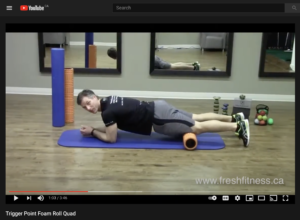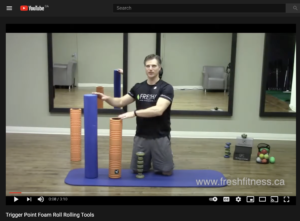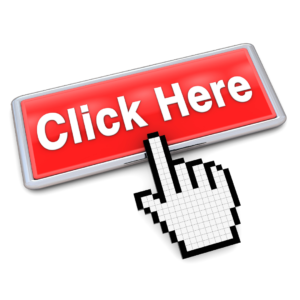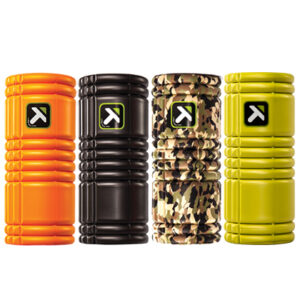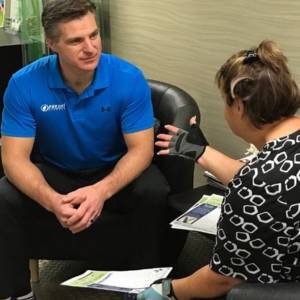Proper Recovery to Avoid Injury & Increase Performance
Have you ever wondered why we don’t recommend working out hard EVERY day of the week? Well, the main reason is that it would put you at a greater risk of injury! It’s still important to do some physical activity each day, but the nature of that activity should vary considerably.
By nature, most of the FRESH! classes are INTENSE and designed to challenge your entire body. Because of this, the days in between your training sessions should be aimed at helping you recover more effectively so that you can work hard again at the next session.
There are many things you can do on your “off” days, but the general guidelines are to do your longer, less intense activities (such as a brisk walk, light run, Yoga, stretching, or another similar mode of exercise).
I’m going to let you in on a little secret that’s helped me and thousands of clients recover properly and avoid injury countless times over the past 10 years.
In fact, these same tools are used by physiotherapists to help people rehabilitate from injury. Using the same concepts, they will help you avoid injury altogether!
Foam Roll and Trigger Point Therapy (TPT) are YOUR BEST FRIENDS!
If you’ve ever had deep tissue massage, you know that it provides amazing relief for sore muscles and helps get healing blood flow into areas of muscle tension (“knots”). Massage is great but can get very expensive. 5 minutes per day of Foam Roll or TPT can do the same job (or better) and it won’t cost you thousands of dollars!
The legs are the biggest area of exercise related pain and tension, so I’m going to focus on two key spots for this success tip. However, the concepts of releasing knots/tension in muscles apply to virtually every external muscle in the body. Foam rollers are the most common tool to do this type of recovery, but TPT is gaining popularity because it is much more versatile and targeted than a traditional foam roll.
Your “IT Band”, “Quads” and Knee Pain
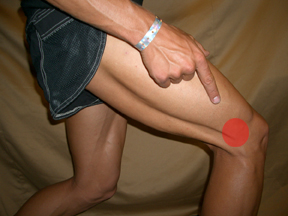 One widely heard complaint is “My IT band is tight.” This tendon, the iliotibial tract, runs down the side of the leg. It originates in the hip area and inserts on the side of the knee. Although the term “IT band” refers to a specific tendon, it is important to understand that your hip, quads, and glutes can influence your IT band’s functionality. Furthermore, biomechanical problems such as a chronic pelvic tilt and poor foot functionality can lead to IT band challenges.
One widely heard complaint is “My IT band is tight.” This tendon, the iliotibial tract, runs down the side of the leg. It originates in the hip area and inserts on the side of the knee. Although the term “IT band” refers to a specific tendon, it is important to understand that your hip, quads, and glutes can influence your IT band’s functionality. Furthermore, biomechanical problems such as a chronic pelvic tilt and poor foot functionality can lead to IT band challenges.
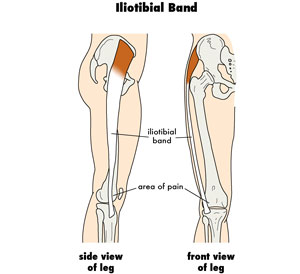 IT band issues are a culmination of muscular challenges in the entire quad/hip region. You might feel aches and pains up and down the side of your leg and a sharp pain on the outside of your knee. You’ve tried everything in the book to fix it. Rest, stretching, and icing have not worked. Then, one day you find that the taut band feels like a stiff old rope and it’s closer to your hamstring than where you thought your IT Band should be. You know nothing else to do other than stretch, but you find that you feel the same the next time you run or exercise. Now, your hip and groin are affected as they lack flexibility and strength.
IT band issues are a culmination of muscular challenges in the entire quad/hip region. You might feel aches and pains up and down the side of your leg and a sharp pain on the outside of your knee. You’ve tried everything in the book to fix it. Rest, stretching, and icing have not worked. Then, one day you find that the taut band feels like a stiff old rope and it’s closer to your hamstring than where you thought your IT Band should be. You know nothing else to do other than stretch, but you find that you feel the same the next time you run or exercise. Now, your hip and groin are affected as they lack flexibility and strength.
To eliminate the underlying problem, you really need to address the muscular imbalance that causes the pelvic tilt. Once the pelvis tilts, it pushes your butt out. This puts stress on your IT bands and surrounding muscles causing them to lengthen beyond their natural capacity. This can trigger irritation in the insertion point just to the outside of the knee (not to be confused with pain felt in the insertion of the anterior tibialis in the lower leg).
 Once again, the IT band is not a muscle. It is a superficial thickening of tissue on the outside of the thigh originating on the outside of the pelvis and inserting below the knee. This band is crucial to stabilizing the knee during running and walking.
Once again, the IT band is not a muscle. It is a superficial thickening of tissue on the outside of the thigh originating on the outside of the pelvis and inserting below the knee. This band is crucial to stabilizing the knee during running and walking.
Although IT band issues are most often associated with running, other activities such as biking, swimming, jumping, hopping, skipping, walking, and hiking involve the outside of the quads. Once you become dehydrated and the muscles surrounding the IT band lose sufficient oxygen or blood flow, they will stick together and form adhesions. These adhesions can result in your quads shutting down. Then, the outside of your leg and ankle will feel every step..
Here are some TPT exercises & videos that you can do to relieve the muscle tension associated with your hard workouts!
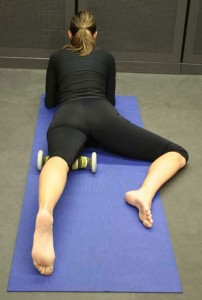 TPT Positioning for the quads (0-degree angle)
TPT Positioning for the quads (0-degree angle)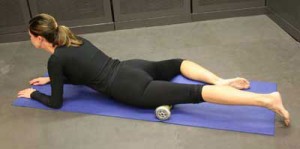
(using the Quadballer Tool)
Keep this angle and roll several inches up and down from the start position. Change position so that the entire length of the muscle is covered. Pay particular attention to “hot spots” that are very sensitive. Relax your muscles completely, keep breathing steady, and focus on the “hot spots”
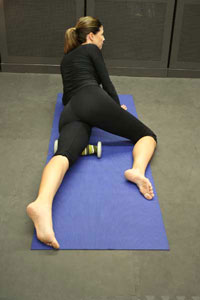 TPT Positioning for the IT Band & Quads (45-degree angle)
TPT Positioning for the IT Band & Quads (45-degree angle)
(using the Quadballer Tool)
Keep this angle and roll several inches up and down from the start position. Change position so that the entire length of the muscle is covered. Pay particular attention to “hot spots” that are very sensitive. Relax your muscles completely, keep breathing steady, and focus on the “hot spots”
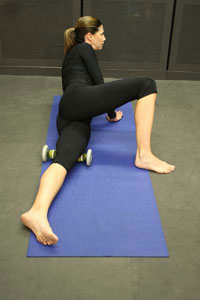 TPT Positioning for the IT Band (90-degree angle)
TPT Positioning for the IT Band (90-degree angle)
(using the Quadballer Tool)
Keep this angle and roll several inches up and down from the start position. Change position so that the entire length of the muscle is covered. Pay particular attention to “hot spots” that are very sensitive. Relax your muscles completely, keep breathing steady, and focus on the “hot spots”
Watch this video to see how to use the TPT Quadballer
As mentioned, TPT is one of the best ways to ensure that your body is functioning properly, you are recovering from exercise and you are dramatically reducing your risk of injury!
To find out more details on Trigger Point Therapy, just contact us. We have a number of kit styles available. Here is our most popular kit. It’s called the Hip Dysfunction Kit and contains:
Trigger Point Therapy – Performance Collection
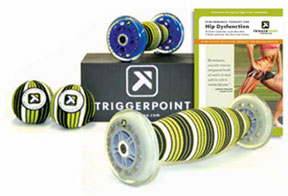 1 – Quadballer (as seen in the video)
1 – Quadballer (as seen in the video)
2 – TP Therapy Balls
1 – Calf Baller
1 – Baller Block
1 – Instructional DVD
Unlimited – Relief from muscle pain!
This magical little tool will literally save you thousands of dollars on massage, physio, Chiro and ART!
The price for this amazing package is only $199.95. PLUS this little TPT kit will SAVE YOU THOUSANDS of dollars in Massage, Chiropractic, Physiotherapy, IMS, and other treatment modalities because you will be able to prevent a huge percentage of the ailments that these professional services are normally needed for.
Now you can save your money for when your condition really warrants seeing these valuable professionals!
I’ve personally seen the benefits of this product and it’s why I started using it with my clients. 5 minutes per day is truly a way to eliminate a huge number of the traditional ailments surrounding muscle tightness. Just call or email with any questions and I would be happy to discuss the benefits of Trigger Point with you in more detail!
Yours in Health
Tim Borys
P.S. If budget is an issue, my next recommendation is to get the TPT Grid 2.0 (or 1.o). While it’s not as versatile and won’t get as deep as the tools listed above, it is still light years ahead of a traditional foam roller in terms of effectiveness, and will last 10x longer than old school foam rollers.
The Grid 2.0 is longer (more the size of traditional roller), whereas the Grid 1.0 is half the size. I personally like the 2.0 because there are some additional things you can do with it along the spine, back, and with 2 legs. However, it’s not as portable as the 1.0. Either way, they are very effective and the choice is more personal preference. You can’t go wrong, and your muscles will thank you!
Grid 2.0 = $89.95
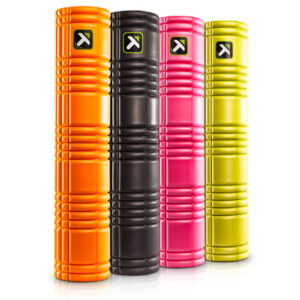
Grid 1.0 = $64.95

